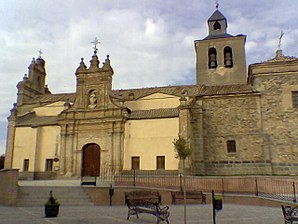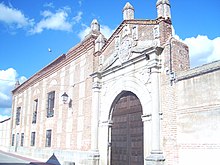Adanero
| Adanero municipality | ||
|---|---|---|
 Adanero - Iglesia de la Asunción de Nuestra Señora
|
||
| coat of arms | Map of Spain | |

|
|
|
| Basic data | ||
| Autonomous Community : | Castile and Leon | |
| Province : | Ávila | |
| Comarca : | La Moraña | |
| Coordinates | 40 ° 57 ′ N , 4 ° 36 ′ W | |
| Height : | 910 msnm | |
| Area : | 31.42 km² | |
| Residents : | 196 (Jan. 1, 2019) | |
| Population density : | 6.24 inhabitants / km² | |
| Postal code : | 05296 | |
| Municipality number ( INE ): | 05001 | |
| administration | ||
| Website : | Adanero | |
Adanero is a central Spanish town and municipality ( municipio ) with 196 inhabitants (as of January 1, 2019) in the province of Ávila in the autonomous region of Castile-León .
Location and climate
The place Adanero is on the Autopista AP-6 almost 38 km (driving distance) north of Ávila at an altitude of about 910 m . The climate in winter is quite cool, whereas in summer it is dry and warm; the low amounts of precipitation (approx. 395 mm / year) fall - with the exception of the almost rainless summer months - distributed over the whole year.
Population development
| year | 1857 | 1900 | 1950 | 2000 | 2018 |
| Residents | 1,001 | 994 | 823 | 341 | 202 |
The continuous decline in population since the beginning of the 20th century is mainly due to the mechanization of agriculture , the abandonment of small farms and the associated loss of jobs.
economy
The economic life of Adanero is largely agrarian - in the past, cereals, vines, etc. were planted for self-sufficiency ; Vegetables came from the house gardens. Cattle breeding (in the past mainly sheep and goats, today mostly cattle) and forestry (mainly for the production of charcoal ) were also operated. Small traders, craftsmen and service providers of all kinds have settled in the village.
history
Parts of a vessel from the Visigothic period were discovered in the municipality . In the 8th century the Moors overran the region; However, nothing is known of a local foundation. In the 11th century the area was recaptured ( reconquista ) and repopulated ( repoblación ) by the Christians . The first mention of the place name comes from the year 1250. Under Philip IV (ruled 1621–1665) Adanero received city rights (villa) . Under Charles II (r. 1665–1700) the title of "Count of Adanero" was created in 1691.
Attractions
- The main attractions of the place are all in the Plaza Mayor .
- The Iglesia de la Asunción de Nuestra Señora is dedicated to the Assumption of Mary and was built between 1563 and 1584 on the site of a previous Romanesque building ; it has a bell tower (campanario) and a small bell gable (espadaña) . There is an imposing gable above the south and west portal . The three-aisled interior houses a painting by Bartolomé Esteban Murillo and a remarkable altarpiece from the 16th century.
- The Ermita de Jesús Nazareno stands near the cemetery. It has a bell gable and a dome resting on an octagonal drum .
- The Palacio de los condes de Adanero was built in the late 17th century in the Mudejar style (wall surfaces made of partially plastered brick ). The granite stone portal with a royal escutcheon is remarkable .
Sons and daughters
- Manuel Basulto Jiménez (1869–1936), Roman Catholic clergyman, Bishop of Jaén and martyr
Web links
- Adanero, sights - photos + information (Spanish)
Individual evidence
- ↑ Cifras oficiales de población resultantes de la revisión del Padrón municipal a 1 de enero . Population statistics from the Instituto Nacional de Estadística (population update).
- ↑ Adanero - climate tables
- ^ Adanero - population development
- ^ Adanero - Iglesia
- ↑ Adanero - Ermita
- ↑ Adanero - Palacio

